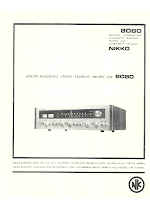Link: radiomuseum | elektrotanya
Оконечник собран на: NEC 2SD188 & NEC 2SA627 попарно в каждом канале.
Country: Japan
Manufacturer / Brand: Nikko Electric Manufacturing Co., Ltd.; Tokyo
Year: 1975 ?
Category: Broadcast Receiver - or past WW2 Tuner
Semiconductors (the count is only for transistors) Semiconductors present.
Main principle Super-Heterodyne (Super in general)
Wave bands Broadcast (BC) and FM or UHF.
Details
Power type and voltage Alternating Current supply (AC) / 220 Volt
Loudspeaker - This model requires external speaker(s).
Power out 160 W (unknown quality)
Model: STA-8080 - Nikko Electric Manufacturing
Material Wooden case
Shape Book-shelf unit.
Dimensions (WHD) 450 x 400 x 140 mm / 17.7 x 15.7 x 5.5 inch
Notes
Semiconductors (the count is only for transistors) Semiconductors present.
Main principle Super-Heterodyne (Super in general)
Wave bands Broadcast (BC) and FM or UHF.
Details
Power type and voltage Alternating Current supply (AC) / 220 Volt
Loudspeaker - This model requires external speaker(s).
Power out 160 W (unknown quality)
Model: STA-8080 - Nikko Electric Manufacturing
Material Wooden case
Shape Book-shelf unit.
Dimensions (WHD) 450 x 400 x 140 mm / 17.7 x 15.7 x 5.5 inch
Notes
- Leistungsaufnahme: 290 W, Eingänge: 2x Phono (1,9 mV, 47 kOhm), 2x Band (160 mV), Reserve: (150 mV).
- Ausgänge: 2x Band, Pre-Out, UKW Quattro, Kopfhörer (6,3mm Klinke, vorne, 200 Ohm), 2 Lautsprecherpaare (4-16 Ohm).
- Verstärkerdauerleistung: 2x 65W an 8 Ohm, 2x 80W an 4 Ohm, Gesamtklirrfaktor: 0,1%
Price in first year of sale 1,499.00 DM
![Infrequent Sound [sex.tex] technology](http://4.bp.blogspot.com/-qIMgdf_L0q8/VIAov-XWowI/AAAAAAAAZ1U/VP46AKJG09k/s1328/1%2B2.jpg)















































